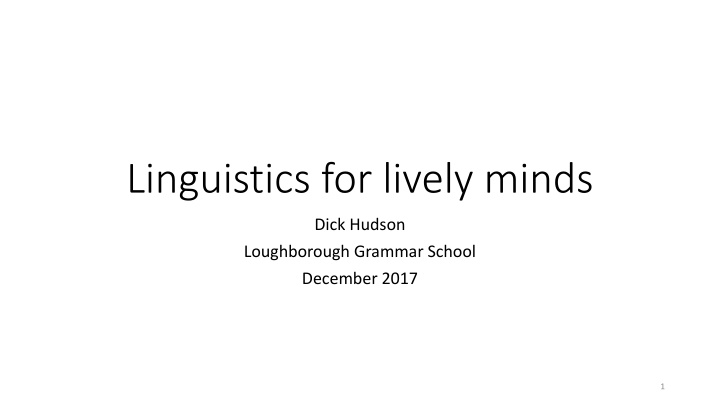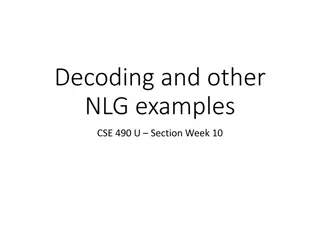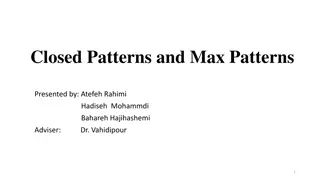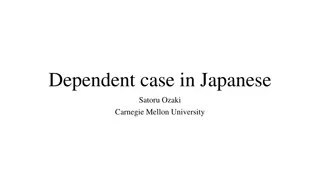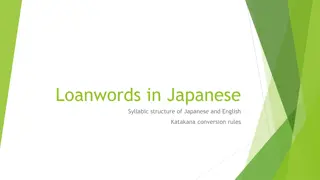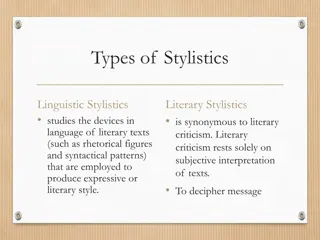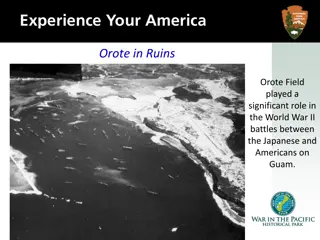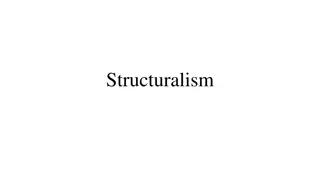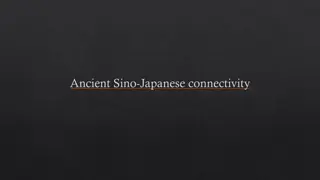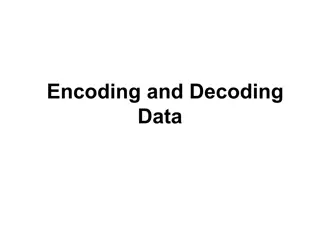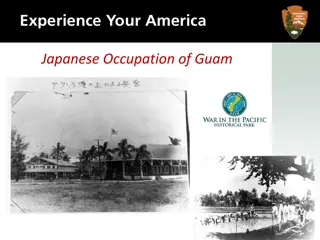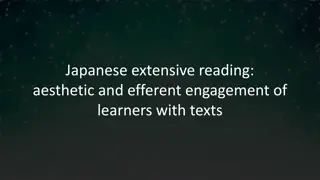Decoding Japanese Language Patterns Through Linguistic Analysis
Explore the intricacies of the Japanese language script, including Kanji, Katakana, and Hiragana characters. Delve into a puzzling journey of deciphering meanings, characters, and syllables, drawing comparisons between word lengths and exploring linguistic systems. Join the quest to unravel the challenge of understanding the characters in Japanese script and grasp how languages are structured and organized.
Download Presentation

Please find below an Image/Link to download the presentation.
The content on the website is provided AS IS for your information and personal use only. It may not be sold, licensed, or shared on other websites without obtaining consent from the author.If you encounter any issues during the download, it is possible that the publisher has removed the file from their server.
You are allowed to download the files provided on this website for personal or commercial use, subject to the condition that they are used lawfully. All files are the property of their respective owners.
The content on the website is provided AS IS for your information and personal use only. It may not be sold, licensed, or shared on other websites without obtaining consent from the author.
E N D
Presentation Transcript
Linguistics for lively minds Dick Hudson Loughborough Grammar School December 2017 1
Exploring other languages: Japanese Japanese script uses three kinds of characters: Kanji (Chinese characters) meaning-based used for Japanese translations of Chinese words Katakana sound-based used for words borrowed from other languages e.g. (konpy ta, "computer ) Hiragana used for Japanese words where Kanji doesn t work or is too posh 2
A puzzle: Japanese hiragana phonetic script Q1. Are meanings relevant? Q3. One character per ? Q5. Can we solve the puzzle now? How does it work? Q2. One character per letter/sound? Q4. Left-right or right-left? Check Wikipedia ...or work it out! 3
More data, and the puzzle deepens do tsu n Bad news! The two columns are ordered separately! can character = n? If character = syllable, how ka How many syllables in harden? What s the second How can we know how they correspond? vowel? Compare word-lengths! Maths or language? Is n special in other ways? longest longest 4
The challenge Not in basic data Not in basic data How can we know what these characters are? Work them out! 5
How does the system work? voiceless voiced 6
Welcome to linguistics! Finding out how languages work Look at the data! Looking for patterns and systems Not just random facts General categories applying to all languages E.g. voicing (voiced/voiceless) But every language is organised differently 7
Explore our ancestor, Old English 450 on: Spoken by the Anglo-Saxon EU immigrants from Germany Replaced both low-class Welsh and high-class Latin. Strongly influenced by Old Norse, the language of the next wave of EU immigrants: the Vikings Written, e.g. Beowulf Nowadays called Old English, but previously called Anglo-Saxon 1066: Replaced in writing by French and Latin Renamed Middle English Re-emerged in writing in the 14th century, e.g. Chaucer 2015: it featured in the UK Linguistics Olympiad 8
nominative accusative case But we still have the relics of case What have we lost since Old English? But we still have the relics of dual Singular dual plural 9
Possession in Ulwa Ulwa is spoken in Nicaragua It contains some English words But it s not English! e.g. it distinguishes inclusive us = me and you exclusive us = me and someone else 10
Ulwa (Nicaragua) From English 11
suffix 'infix' Zooming in on Ulwa Suffix or infix? Infix after an initial long syllable (CVV or CVC). Otherwise suffix. -kana = "their" -ni = "our (inc)" -ma = "your (sing)" -mana = "your (plur)" 12
Manam Island A small volcanic island. On the Equator. Equator 13
What are they like in Manam? They're like us. They enjoy a day at the seaside. 15
Try the Manam puzzle From the North American Computational Linguistics Olympiad Be prepared to question your initial assumptions! 16
Manam Island, Papua New Guinea auta = North ilau = South uklo.org The sentences below tell us where Onkau, Kulu, Mombwa, Tola, Sulung, Sala, Pita and Butokang live. Can you work out who lives where? 1. 17
Manam Island, Papua New Guinea auta = North ilau = South auta = North ilau = South uklo.org ata = West awa = East The sentences below tell us where Onkau, Kulu, Mombwa, Tola, Sulung, Sala, Pita and Butokang live. Can you work out who lives where? 1. 2. 18
Manam Island, Papua New Guinea auta = North ilau = South auta = North ilau = South uklo.org ata = West awa = East The sentences below tell us where Onkau, Kulu, Mombwa, Tola, Sulung, Sala, Pita and Butokang live. Can you work out who lives where? 1. 5. Sala 19
Manam Island, Papua New Guinea auta = North ilau = South auta = North ilau = South uklo.org ata = West awa = East The sentences below tell us where Onkau, Kulu, Mombwa, Tola, Sulung, Sala, Pita and Butokang live. Can you work out who lives where? Tola 1. 3. 5. Sala 20
Manam Island, Papua New Guinea auta = North ilau = South auta = North ilau = South uklo.org ata = West awa = East The sentences below tell us where Onkau, Kulu, Mombwa, Tola, Sulung, Sala, Pita and Butokang live. Can you work out who lives where? Tola 4. 1. 3. Sulung 5. DEAD END! Sala THINK AGAIN! 21
Manam Island A small volcanic island. On the Equator. Equator 22
Manam Island, Papua New Guinea uklo.org New idea: Use the volcano peak as reference point A red herring! The sentences below tell us where Onkau, Kulu, Mombwa, Tola, Sulung, Sala, Pita and Butokang live. Can you work out who lives where? 1. auta = up ilau = down 24
Manam Island, Papua New Guinea uklo.org up/down The sentences below tell us where Onkau, Kulu, Mombwa, Tola, Sulung, Sala, Pita and Butokang live. Can you work out who lives where? clockwise/anti-clockwise = left/right when looking up 1. 2. auta = up ilau = down ata = left awa = right 25
Manam Island, Papua New Guinea uklo.org The sentences below tell us where Onkau, Kulu, Mombwa, Tola, Sulung, Sala, Pita and Butokang live. Can you work out who lives where? 1. 2. auta = up ilau = down ata = left awa = right Sala 5. 26
Manam Island, Papua New Guinea uklo.org The sentences below tell us where Onkau, Kulu, Mombwa, Tola, Sulung, Sala, Pita and Butokang live. Can you work out who lives where? Sulung 4. Tola 1. 3. 2. auta = up ilau = down ata = left awa = right Sala 5. 27
Manam Island, Papua New Guinea uklo.org The sentences below tell us where Onkau, Kulu, Mombwa, Tola, Sulung, Sala, Pita and Butokang live. Can you work out who lives where? Success!! Pita 8. 6. Butokang Sulung 4. Tola 1. 3. 2. 7. auta = up ilau = down ata = left awa = right Sala 5. 28
So what? Languages are structured Not just a random collection of bits. Linguistics investigates this structure It s a science, where hypotheses can be tested. The structure is really interesting because it varies enormously between languages. it can change. it s very complex. it affects how we talk about the world and even how we understand it. it s part of our minds. 29
Thank you. This show is downloadable: dickhudson.com/talks For more information about UKLO (the Linguistics Olympiad): www.uklo.org 30
